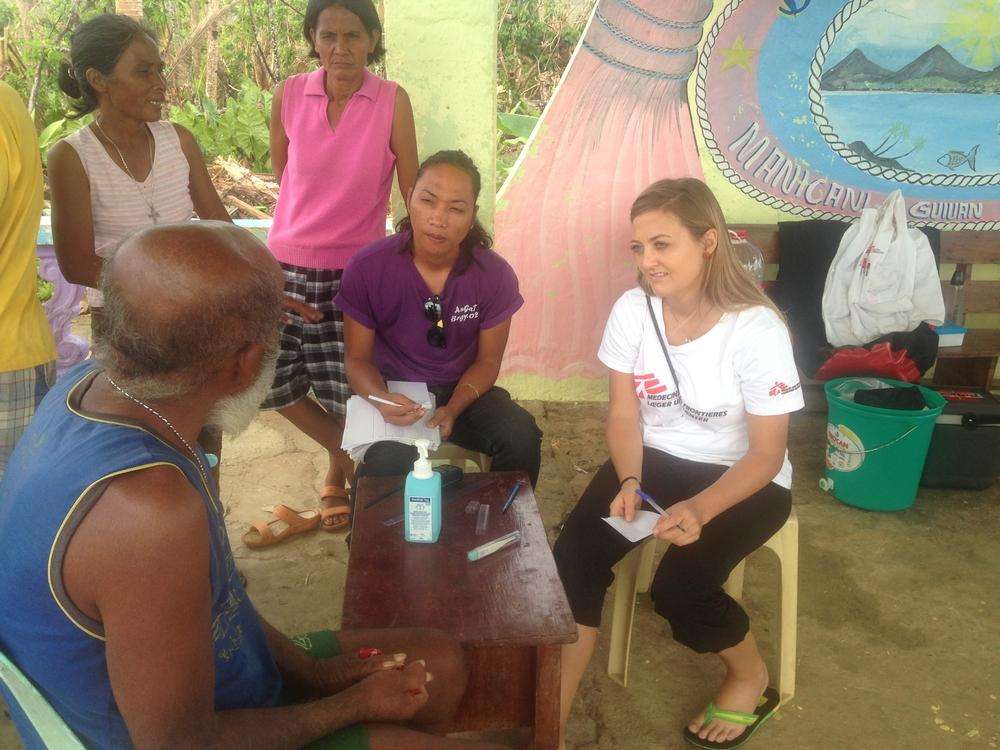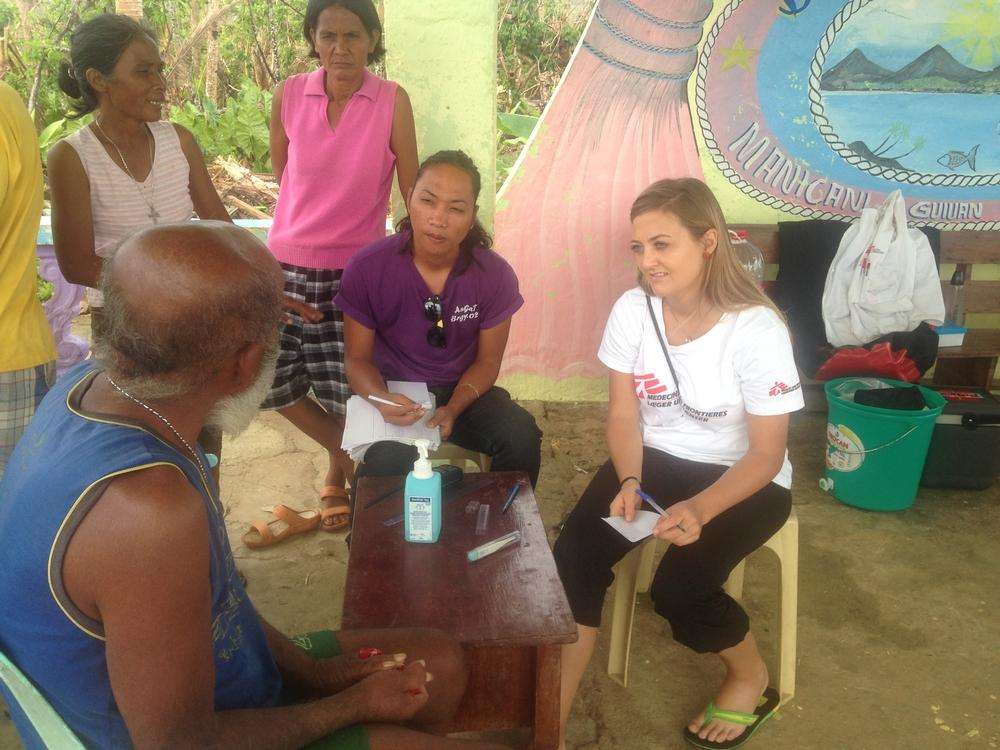Over the past seven weeks, a Doctors Without Borders/Médecins Sans Frontières (MSF) team has run mobile clinics by boat to deliver medical and humanitarian aid to five islands south of Guiuan that were affected by Typhoon Haiyan.
The team includes a doctor, two nurses, a psychologist, a translator, and two Filipino health workers. They can treat up to 200 patients per day, doing minor operations on the islands and referring complicated cases to MSF’s hospital in Guiuan.
Florence Denneulin, a nurse from France, arrived in Guiuan one week after the typhoon. She took part in the initial assessments of the islands by helicopter before setting up and running the boat outreach clinics.
“Our priority was to get out to the most isolated islands, where we thought the needs would be greatest. When I arrived I found everything was destroyed—houses, roads, trees were uprooted. Those trees left standing had no leaves. There was debris everywhere—pieces of glass, wood, iron sheeting. Even the health clinics and hospitals had been destroyed.
People were happy to see us coming with medicines and health workers. They hadn’t been able to communicate with anyone and because all the boats were destroyed there was no transport for people to get off the islands. We treated a lot of patients—one of our doctors saw 205 patients in a single day. We had a lot of dressings to do because people were wounded when their houses collapsed or when the trees fell down. There were glass and cans everywhere and some people had lost their shoes. Even with flip-flops on, people had badly injured their legs.
We sometimes use trucks to travel across the islands. The roads are not concrete, so if it rains it gets incredibly muddy and the trucks can’t take us. Then we have to trek along muddy trails, sometimes uphill—all the time carrying our medicines and equipment.”
Doctor Mads Geisler, from Denmark, arrived in the Philippines one month after the typhoon.
“We set up wherever there is half a roof, anywhere we can do consultations. At the start I was treating more than 100 people each day. Now we are treating fewer patients, but it’s still a lot more than you would treat at home.
I saw lots of people who injured themselves in the clean-up operation. On the islands people didn’t have bulldozers to clear the way, so people were constantly stepping on things, scraping themselves. In this climate there’s a high risk of infection due to the heat and the moisture—we saw lots of cases of skin infections and some cases of tetanus. Tetanus is a very dangerous condition and this climate, with all of the debris and wounds, is ideal for it. A big part of our work is wound cleaning and dressing, plus tetanus boosters and injections.
In general people are extremely optimistic—even in places that were flattened, where everyone lives in tents. The fact that everyone lived through the same disaster seems to have had a very positive effect on people’s coping mechanisms. Even so, I see patients who are experiencing stress and psychosomatic symptoms—body pain, discomfort, numbness of hands and feet, headaches, palpitations, and insomnia.
It really feels like we have made a big difference, but there is still a lot of infrastructural work to be done. The islands still look completely destroyed—nothing is intact—it is going to take a long time.”
Kristine Langelund, a nurse from Denmark, arrived in the Philippines in early December.
“As a nurse I do a pre-consultation before patients see the doctor, so we can decide which cases are the priority. I remember one man in his forties who had lost his family—his wife and their four children. He was incredibly polite. He said he knew that he wasn’t the sickest person, but he wanted some medication for his back pain so he could start rebuilding his home and his life.
One of the smallest islands that we visited is called Victory. It only takes 15 minutes to travel across. Sixty people live there and all of the homes were destroyed. There are still 15 people missing, more than half of them children.
Some of the islands are very isolated. I remember one patient, a girl who had slipped over and bumped her head. She was feeling dizzy and had had a blackout. In Denmark we would have told her to go home to rest, but her family were really frightened. We knew that after we left there would be no medical care available for two weeks. So we took her and her family back with us to the hospital in Guiuan.”
Ana Cecilia Weintraub, a psychologist from Brazil, arrived in the Philippines in early December.
“Most people are dealing with the typhoon in the most positive way possible under the circumstances. There are some acute mental health cases, but only about half are related to the typhoon, the others are chronic patients who were already suffering. I am also seeing some cases of children who are crying, are very afraid, and cannot bear to be away from their parents. I try to work with the family to show them that their child’s reaction is completely understandable.
As a part of my therapy sessions on the islands I have asked children to draw a picture of their community before and after the typhoon, and another as they would like it to be when it has been rebuilt. We do all of the drawings on the same piece of paper. Then we make the paper into a boat and set it out to sail on the sea with a wish. I explain to the children that where I am from in Brazil, this is something that we do at this time of year, hoping that the New Year will bring good things to everyone.
People’s psychological recovery also depends on the rebuilding effort. If the physical environment doesn’t improve, if it takes a long time for people to rebuild their lives, they may still be stressed—it is not a disease but a social problem.”
In the two months since MSF started working in the Philippines, emergency teams have carried out 66,795 patient consultations, admitted 1552 patients into hospitals, performed 365 surgeries, and delivered 395 babies. MSF has also distributed 62,925 items of humanitarian relief including reconstruction kits, shelter kits, hygiene kits, and cooking sets.





